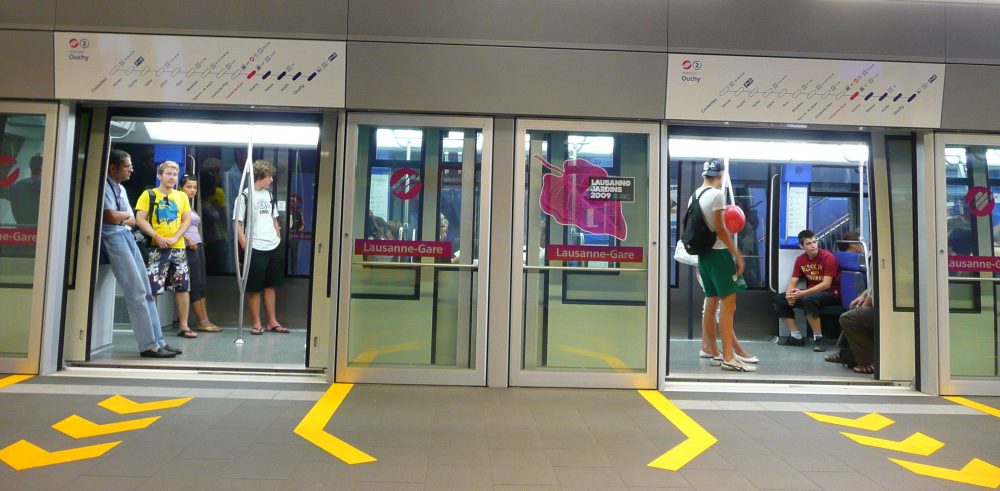Annette Motta and Valeria Versari
Abstract
In this paper, we aim to understand which clientele is targeted by the restaurants and the relevance of their location near to the railway station of Renens through an analysis of multilingual signs. Using the theoretical concepts of main and secondary languages, we hypothesized that the location of the restaurants near the station would deeply affect their market strategy and hence of their use of multilingual signs in storefronts and in their menus based on their target audience. We collected a corpus of 10 photos and selected four multilingual storefronts and menus, and afterwards analysed the Trip Advisor reviews in order to identify the possible different clientele. The results turned out to correspond with the hypothesis: all restaurants use main and secondary languages differently for their different target audience and marketing strategies and it seems to match with their location as well.
1. Introduction
Nowadays, multilingualism is present in the economic sector of the majority of cities. A frequent example of multilingualism in the everyday life are ethnic restaurants: they often try to represent the culture and ethnicity they represent by their use of languages on the storefronts and menus.
In this paper we will try to analyse the relationship between multilingual restaurants and their location in Renens and specifically near the railway station. We are going to try to understand if these restaurants are targeting specific customers by showing their authenticity and belonging or if they are pointing to a larger customer base through their language choice in signs. Our hypothesis was that there had to be a relation between the restaurants, the languages used and their location and population of the area.
In the theoretical framework, we will focus on main and secondary language and their power in given areas: how they are used as marketing strategies. In the contextualisation we will explain why we thought that Renens’ railway station would be a good location for our research. We will then explain our methodology, how we studied our data consisting in photos taken on the place of the storefronts and menus and Trip Advisor reviews of customers. We will analyse these data in the result section and in the end we will discuss our findings.
2. Theoretical Framework
Multilingualism is an aspect more and more present in our society due to the rise of media and globalisation, as well as the intensified economic migration. Multilingualism in the restauration field has a great place as gastronomy is overcoming the boundaries between cultures, as a great number of people likes to try out foreign gastronomy. Many studies have been conducted on the significance of the use of two languages in advertisements and storefronts.
In the restaurants we selected, the use of the official language, French in Renens, is shadowed by the use of secondary languages, in our corpus Chinese, Thai and Portuguese. As stated by Jasone Cenoz et al, “the linguistic landscape reflects the relative power and status of the different languages in a specific sociolinguistic context” (2006, p. 67), indeed in the storefront of the chosen restaurants, the power of the official language is weakened by the authenticity given by the secondary language, pointing out the importance of a secondary language in such a touristic area to attract people.
3. Contextualisation
Switzerland is a strongly multilingual country itself with its four official languages (German, French, Italian and Romansch). The francophone city of Renens benefits of a strategic location near the fairly big city of Lausanne in the canton Vaud. As a peripheric city, Renens is a less expensive living area and hence leads to the coming of more multilingual citizens arriving from diverse linguistic backgrounds than in Lausanne itself. Indeed, in 2000, Renens was inhabited by more than 50% of migrants from different countries. This multiethnic population brought Renens to be a strongly multilingual city favouring the expansion of multilingual restaurants.
Moreover, the railway station of Renens has become a fairly busy train station. Indeed, statistics recently showed that during the working days more than 20’000 passengers travel through the railway station of Renens. The high movement of people also increases the multilinguality of the area and thus provides an interesting linguistic landscape. The creation of the metro M1 in 1991 directly connected Renens to the central place of the Flon in Lausanne and to the University of Lausanne, which are both multilingual areas, thus increasing the number of multilingual passengers travelling through Renens.
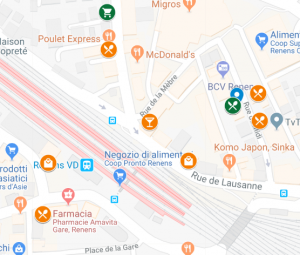
Picture 1: Collective Google Map of the data collected.
Picture 1 shows where we took the pictures around the Renens’ railway station.
4. Methodology
We collected the data for this paper by looking for different restaurants with multilingual signs around the area of the rail station of Renens and by taking pictures of their banners and menus. We chose this area for two main reasons: firstly, Renens is a particularly multiethnic centre and has a high number of migrants and foreign citizens, so we assumed that this would probably lead to having also more multilingual citizens, although this is not always the case. Secondly, because the railway station provides even more intercultural exchanges and thus again we thought that this would also mean more language exchange and use.
Before collecting the data, we supposed that Renens, due to its high number of migrants, would probably show more multilingualism than other areas around Lausanne. In fact, there are many shops, bars and restaurants that exhibit more than one language on their signs and in their menus, although we were expecting to find more.
We collected a corpus of 10 photos of different multilingual restaurants and adverts. In the end, we chose to exclude the advertisements and made a selection of only three restaurants in particular, because they had both languages both in the banner and in the menu and seemed particularly close to showing their different national identity and tradition through language. Afterwards, we analysed the reviews on Trip Advisor and Google to see if they would give us a deeper insight on the clientele of the restaurants.
This method could not be comprehensive enough, as we did not manage to actually talk to people and the only owner of a restaurant that we managed to talk to was not willing to reply to our questions and we could therefore only rely on unofficial reviews. Moreover, the data is not really exhaustive itself as 10 photos are not enough to draw certain conclusions.
5. Results
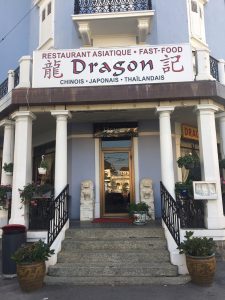
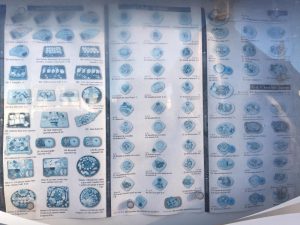 Picture 2, 3: Dragon
Picture 2, 3: Dragon
This is an Asiatic fast-food restaurant that offers Chinese, apanese and Thai food just outside the railway station. The name of the restaurant “Dragon” is already evocative of the Chinese culture, as the dragon is a symbol of Chinese culture in general, it is attributed to Eastern culture by Western citizens and it could therefore be used as a form of commodification to sell certain services. The main language used is French, not only on the banner but on the menu as well. However, Chinese is also used even if it is clearly given less importance: on the two sides of ‘Dragon’ and above every dish in the menu, written in a very small font but still shown. We were surprised that Japanese and Thai languages are not featured at all, although they are part of the restaurant’s offerings.
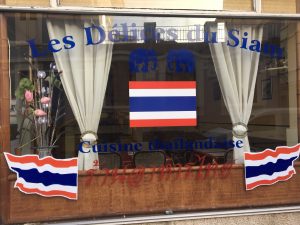
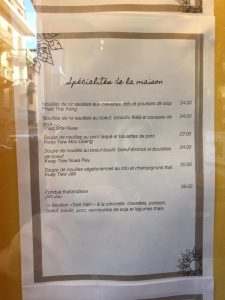 Picture 4, 5: Les délices du Siam
Picture 4, 5: Les délices du Siam
“Les délices du Siam” is a little restaurant located near the railway station of Renens. On the storefront of the restaurant there are three Thai flags and two elephants, which are holy animals in the most widespread religion of Thailand, Buddhism. On top, there is the name of the restaurant written in French, the official language in Renens and under the central flag there is another writing in French that indicates which food is to find in the restaurant: “Cuisine thailandaise”. At the bottom, between the two Thai flags there is something written in Thai The colours of the inscriptions are the one present in the flag of the country. On the menu of the restaurant, the ingredients are written in French but the names of the dishes are written under the ingredients in Thai, so there is a hierarchy of languages.
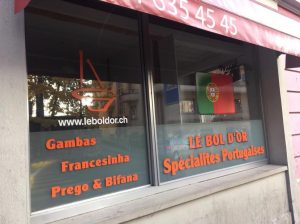
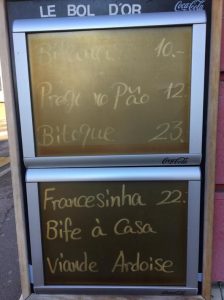 Picture 6, 7: Le Bol d’Or
Picture 6, 7: Le Bol d’Or
This is a Chinese and Portuguese restaurant. The languages used outside are French and Portuguese, both on the window (in picture) and in the menu. This is why we were surprised when we found out, entering the restaurant, that it is also Chinese. The fact that if you only look at the facade of the restaurant and at the menu given outside only Portuguese is given is surprising. We also went inside to interview the owner, and although we couldn’t speak to him directly, we noticed that the decorations were a mixture of Asian and Western culture but both the personnel members present were Asian and hardly spoke French, whilst the only table with customers was occupied by a Portuguese speaking family.
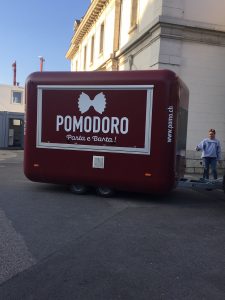
Picture 8: Pomodoro Pasta e Basta!
This is not a restaurant but a food truck that was placed right at the exit of the station, presenting Italian in its name. We did not manage to take a picture of its menu but it was entirely in French. It is therefore a different case from all the others described above and shows that its aim is probably to target rather French locals more than tourists or Italian-speaking clients. Although Italian is a spoken very frequently by population in Lausanne, being one of the four official languages of Switzerland, it is not present in the menu of this food chain.
6. Discussion
All the restaurants we chose to analyse show bottom-up multilingual signs and they all feature French, which is this region’s official language, and another language. Bottom-up items include “those issued by individuals’ social actors such as shop owners and companies, including names of shops, business, signs and personal announcements” (Akindele 2011: 7). This could be a marketing strategy in order to attract a certain type of customers and to give an authentic image of their national identity in a multilingual and touristic space as a railway station area.
The restaurant “Le Bol d’Or” shows an inconsistency between the storefront and the menu and decoration. Indeed, the storefront presents only Portuguese and French, whilst on the inside the decorations are strongly Asian, as well as the personnel. Although this pairing of cultures (Western and Asian) might sound odd and surprising, it is due to the owners, one being Chinese and one Portuguese. In accordance with some reviews found on Trip Advisor, the decorations are actually seen as exaggerated and therefore as not very authentic. Moreover, we found out that they have two menus, one for Chinese restoration and one for Portuguese restoration even though the storefront gave no information about Asian cuisine. This absence of indications about the kind of cuisine inside the restaurant made us confused about the marketing strategy of the restaurant. However, the clientele seems to be consisted by a higher number of non-French speakers, also if we consider the personnel that really struggles with the local language.
The restaurant “Les Délices du Siam” seems to be very close to the Thai culture as demonstrated by their storefront. Reading the menu, the authenticity of the dishes offered confirm this closeness to the Thai gastronomic culture. Subsequently supported by some of the Trip Advisor reviews, complimenting the authenticity of the dishes and the staff. Some customers even claimed that they felt like they were in Thailand as the dishes tasted like the one they had during some vacations in the country. A client also noticed that the restaurant was often frequented by Thai people and interpreted it as a proof that the food is authentic. Moreover, a positive review of a Thai man confirms the fact that “Les Délices du Siam” is visited by people of Thai nationality. The restaurant being owned by a Thai family, some reviews express a language problem between them and the staff as they hardly spoke French. In addition, the location of the restaurant near the railway station is often cited as a positive aspect.
“Dragon” displays an inconsistency between the offerings and the languages used on the menu and storefront as well: although it offers equally Japanese, Thai and Chinese dishes, only Chinese language is used beside French. This is clearly due to accommodate a certain type of customers: whilst for tourists and Swiss locals Chinese helps making the menu look more Eastern and is therefore only used for visual purposes. We can also assume by this use of language that the number of Chinese speaking customers could be higher than Thai or Japanese speaking. It is therefore a marketing strategy aiming at including as many customers as possible. On the other hand, including Japanese and Thai would have been more inclusive, so their absence is confusing. However, in the Trip Advisor reviews it becomes clear that this results in a lack of authenticity that is often pointed out by the clients.
The food truck “Pomodoro” aims to attract a majority of customers without targeting a specific kind of people. The Italian name only serves to indicate the kind of gastronomy offered in the food truck and to give the feeling that it is authentically Italian. However, the menu is written in French only showing a lack of will to demonstrate authenticity. Because of its mobility, the food truck maybe does not need to focus on a specific clientele as it always moves.
Now, if we consider the restaurants’ locations (picture 1), we can notice that “Dragon” and “Les délices du Siam” are really close to the exit of the rail station: “Dragon” is probably one of the first things that a traveller notices as coming out of the station. Its aim is therefore rather to attract casual travellers than to attract true locals of the identity they represent. On the other hand, “Les Délices du Siam” has the same distance from the station (it literally faces “Dragon”) but is more hidden. It probably aims less to a tourist target and therefore looks more for authenticity, which customers seem to appreciate more. Its decorations are less visible and not given a lot of attention. Both French and Thai are given the same importance, therefore giving a certain importance to local Thai customers in contrast to “Dragon”’s neglected use of Chinese. “Pomodoro Pasta e Basta”’s location just at the exit of the station, being a moveable Food Truck, is another indicator of this strategic position. The fact that “Le Bol d’Or” is on the other side of the station and therefore not directly accessible by the travellers could be the reason why it aims more to Portuguese and Chinese customers than tourists in general.
7. Conclusion
In this research paper, we looked into the use of different languages in ethnic restaurants and the relation with their position in Renens and near the railway station. It was found that main and secondary language play an important role in defining the target audience of the restaurant, whether it wants to attract more just the local residents, mainly francophone, or if it targets more natives of a specific identity represented by the business. This target seems to depend mostly on the location of the restaurant and it affects language just as much as it affects its decoration and appeal on the whole.
However, this research presents many limitations. It might be inaccurate, as we only analysed a limited number of restaurants on a restricted area. The study might be extended to the whole city of Renens and it would be interesting to see how the location affects also activities more distant from the station. It is still relevant to see how deeply the location of the restaurants we analysed affects their use of language as a marketing strategy.
References
Akindele, Dele Olufemi (2011) Linguistic Landscapes as Public Communication: A Study of Public Signage in Gaborone Botswana. International Journal of Linguistics, Vol. 3, No. 1, 1-11.
Jasone C & Durk G. (2006) Linguistic Landscape and Minority Languages. University of the Basque Country, Fryske Academy. International Journal of Multilingualism. Vol 3, No.1. 67.
Commune de Renens. Statistics in 2000. Available at: http://www.scris.vd.ch/Data_Dir/ElementsDir/3274/3/F/5591_Renens_RFP2000.pdf. Accessed on 27.12.2018.
Renens en mouvement. Renens: une gare bien fréquentée! Available at: http://www.renens.ch/enmouvement/Chronologies.php?Nr_Projets=8&news_id=280. Accessed on 27.12.2018.
